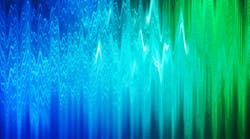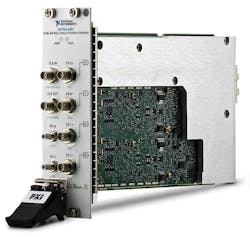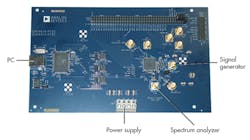Create Complex Waveforms Using Fast Digital Circuits
Download this article as a .PDF
High-frequency signal waveforms flow through everything from communications systems to sophisticated test systems. They are often generated by analog sources, such as different types of oscillators. In recent years, however, as digital components such as digital-to-analog converters (DACSs) have improved in speed and performance, many signal waveforms can now be created starting with digital code and hardware. Signal generators based on digital architectures may be known as arbitrary waveform generators (AWGs), but they are often called direct digital synthesizers (DDS). They may not be able to match all the performance levels of a good phase-locked analog frequency synthesizer, but they have some benefits in terms of the precision and frequency switching speeds of the waveforms they can generate.
In contrast to an indirect analog frequency synthesizer which may use a PLL to lock a tunable frequency source such as a voltage-controlled oscillator (VCO) or a yttrium-indium-garnet (YIG) oscillator to the phase of a reference oscillator, a DDS generates an RF/microwave waveform directly from a high-speed DAC, using digital techniques. It stores the points of a signal waveform in digital form and then recalls a number of the stored points to generate a waveform, with the number of digital bits determining the amplitude resolution of the waveform.
A DDS is also often referred to as a numerically controlled oscillator (NCO). A block diagram for a basic DDS would show a phase accumulator connected to some form of memory to store digital representations of different waveforms, such as a read-only-memory (ROM) or programmable ROM integrated circuit (IC). The phase accumulator is connected to a high-speed DAC capable of generating the frequency range of analog voltage outputs to serve an application of interest. The DAC is usually connected to a lowpass filter (LPF) to remove higher-order harmonic content. A precision reference clock controls the timing of the phase accumulator and other components in the DDS. When there is more than one phase accumulator in a DDS, it can generate modulation, such as frequency-modulated CW (FMCW) signals used in automotive radar systems as part of advanced driver assistance system (ADAS) equipment.
1. The DDS-based NI PXIe-5451 arbitrary waveform generator operates at sampling rates to 400 MSamples/s and produces output waveforms to 160 MHz. (Photo courtesy of National Instruments)
In conventional Nyquist sampling operation, a DDS DAC generates output signals at fundamental frequencies that are less than one-half the frequency of the clock frequency. So, for a DDS DAC operating at a clock rate of 1 GHz, output fundamental tones produced by the synthesizer’s DAC are no greater than 500 MHz in frequency, although usually somewhat less, such as 40% or 400 MHz, to minimize distortion. However, some DDS DACs function in what is known as a “super-Nyquist” means of operation, in which higher-order image frequencies are used as the output signals rather than fundamental tones. Additional filtering, such as a bandpass filter, is needed to suppress any fundamental tones that are generated, and the amplitudes of the image or harmonic signals will be considerably less than those of the fundamental tones, requiring amplification. But in such a way, a DAC-based DDS can also generate output signal waveform frequencies that are considerably higher in frequency than the frequency of the DDS’s clock source.
Different forms of noise, such as phase noise, spurious signals, and harmonic signals, can be produced as part of the signal generation process in a DDS. Noise can originate from various sources, including jitter from the reference clock. Phase noise truncations occurs can occur as part of the sampling process when an insufficient number of bits are available to generate analog output waveforms with low phase noise. Even a high-resolution, high-performance DAC will contribute some noise of its own to the signal-generation process. DAC quantization or linearity errors can cause unwanted phase noise as well as harmonic signals, although proper choice of output filtering, such as a lowpass filter, can significantly reduce harmonic signal levels in a DDS.
Commercial Sources
Signal sources based on DDS technology are commercially available in both instrument enclosures (as test signal generators) and as various forms of packaged ICs. When sorting through various product candidates for an application, some of the parameters and specifications to consider include the maximum clock frequency, the frequency tuning resolution, the bit resolution, the number of channels, spurious-free dynamic range (SFDR), and the power consumption. For system-level applications in which a large number of synchronized multiple channels may be needed, this capability may also be considered important.
A number of manufacturers offer DDS signal sources in board-level form, including as modular test instruments such as the NI PXIe-5451 arbitrary waveform generator from National Instruments (www.ni.com). The PXIe DDS-based generator has two channels with single-ended and differential output signals. Its 16-b DAC operates at sampling rates to 400 MSamples/s, resulting in output waveform frequencies to 160 MHz. It can run with an internal sampling clock or support a wide range of external clocking options for test signal flexibility.
In terms of DDS-based board-level instruments without the enclosure, Novatech Instruments offers their DDS9m four-channel signal generator as a small circuit board module. It can generate sinewaves and LVCMOS output signals simultaneously at frequencies to 170 MHz. The frequency tuning resolution is 0.1 Hz, and the frequencies of the four outputs can be set independently, with controllable phase offsets. The DDS source has an on-board voltage-controlled temperature-compensated crystal oscillator (VCTCXO) reference clock, and works with external clocks at frequencies as high as 500 MHz. An RS-232 interface allows for programmable control in automatic-test-equipment (ATE) applications. Spectral performance includes spurious levels of -50 dBc or better and harmonics of -35 dBc or better.
2. The AD9914 is a 3.5-GSamples/s DDS that is available on an evaluation board for ease of training and applications development. (Photo courtesy of Analog Devices)
The majority of commercial DDS sources are available as packaged ICs, allowing users to surround the digital synthesizer chip with their own choices for supporting components, such as output filters and signal-boosting amplifiers. The AD9914 DDS from Analog Devices, for example, has a 12-b DAC and operates at sampling rates to 3.5 GSamples/s for generating low-noise, microwave output frequencies for use as agile local oscillator (LO) sources or for clock sources in frequency-hopped radios. To simplify the use and understanding of the DDS technology, the company also offers the AD9914 DDS mounted on an evaluation board, so that the synthesizer is essentially ready to power up and connect to a spectrum analyzer for experimentation and observation. Additional suppliers of DDS sources in chip packages include Intersil and Xilinx.
For those seeking to know more about the basics of chip-level DDS signal sources, Analog Devices offers an excellent tutorial lesson on the programming and specifying of DDS sources in the application note, “All About Direct Digital Synthesis,” which is the 33rd installment of the company’s “Ask The Application Engineer” series.



